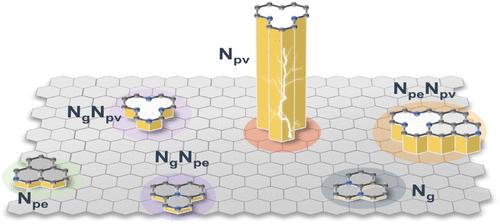Pyridinic-N Dominates ORR Performance: Decoding Configuration-Sensitive Electrocatalysis of N-Doped Graphene Quantum Dots
IF 13.1
1区 化学
Q1 CHEMISTRY, PHYSICAL
引用次数: 0
Abstract
Developing low-cost, high-performance metal-free oxygen reduction catalysts demands precise quantification of structure-performance relationships in nitrogen-doped carbons. Structural search algorithms combined with density functional theory (DFT) enable comprehensive analysis of catalytic performance versus structural features. Using nitrogen-doped graphene quantum dots (NGQDs) as models, we computationally resolve how nitrogen species types (pyridinic-N, graphitic-N) and substitution positions influence the stability and intrinsic activity. Boltzmann statistics quantify the contributions of all configurations to the current density during oxygen reduction. Furthermore, we identify dominant configurations grouping NGQDs into configuration lumps. Thermodynamically, nitrogen atoms preferentially occupy carbon atoms at defect-adjacent sites as pyridinic-N. Their spatial distribution controls local atomic charge redistribution and adsorption environments, thereby modulating intrinsic activity. These materials exhibit extreme configuration sensitivity: thermodynamically stable dominant configurations may contribute minimally to current density. Crucially, lumped pyridinic-N configurations dominate ORR performance. This work provides theoretical insights supporting carbon adjacent to pyridinic-N as the primary active site in N-doped carbon ORR catalysts. It establishes a universal framework for analyzing structure–activity relationships in nonmodel catalytic systems.

吡啶- n主导ORR性能:解码构型敏感的n掺杂石墨烯量子点电催化
开发低成本、高性能的无金属氧还原催化剂需要对氮掺杂碳的结构-性能关系进行精确的量化。结构搜索算法与密度泛函理论(DFT)相结合,可以对催化性能与结构特征进行综合分析。以氮掺杂石墨烯量子点(NGQDs)为模型,计算了氮的种类(吡啶- n、石墨- n)和取代位置对稳定性和固有活性的影响。玻尔兹曼统计量化了氧还原过程中所有构型对电流密度的贡献。此外,我们确定了将ngqd分组为组态团的优势构型。从热力学上讲,氮原子优先占据缺陷邻近位置的碳原子作为吡啶- n。它们的空间分布控制着局部原子电荷的再分配和吸附环境,从而调节内在活性。这些材料表现出极端的构型敏感性:热力学稳定的主要构型对电流密度的影响最小。关键是,总吡啶- n构型支配着ORR的性能。这项工作提供了理论见解,支持邻近的碳吡啶- n作为主要活性位点的n掺杂碳ORR催化剂。它为分析非模型催化体系的构效关系建立了一个通用的框架。
本文章由计算机程序翻译,如有差异,请以英文原文为准。
求助全文
约1分钟内获得全文
求助全文
来源期刊

ACS Catalysis
CHEMISTRY, PHYSICAL-
CiteScore
20.80
自引率
6.20%
发文量
1253
审稿时长
1.5 months
期刊介绍:
ACS Catalysis is an esteemed journal that publishes original research in the fields of heterogeneous catalysis, molecular catalysis, and biocatalysis. It offers broad coverage across diverse areas such as life sciences, organometallics and synthesis, photochemistry and electrochemistry, drug discovery and synthesis, materials science, environmental protection, polymer discovery and synthesis, and energy and fuels.
The scope of the journal is to showcase innovative work in various aspects of catalysis. This includes new reactions and novel synthetic approaches utilizing known catalysts, the discovery or modification of new catalysts, elucidation of catalytic mechanisms through cutting-edge investigations, practical enhancements of existing processes, as well as conceptual advances in the field. Contributions to ACS Catalysis can encompass both experimental and theoretical research focused on catalytic molecules, macromolecules, and materials that exhibit catalytic turnover.
 求助内容:
求助内容: 应助结果提醒方式:
应助结果提醒方式:


